Overlapping and distinct roles of Aspergillus fumigatus UDP-glucose 4-epimerases in galactose metabolism and the synthesis of galactose-containing cell wall polysaccharides
- PMID: 24257745
- PMCID: PMC3894311
- DOI: 10.1074/jbc.M113.522516
Overlapping and distinct roles of Aspergillus fumigatus UDP-glucose 4-epimerases in galactose metabolism and the synthesis of galactose-containing cell wall polysaccharides
Abstract
The cell wall of Aspergillus fumigatus contains two galactose-containing polysaccharides, galactomannan and galactosaminogalactan, whose biosynthetic pathways are not well understood. The A. fumigatus genome contains three genes encoding putative UDP-glucose 4-epimerases, uge3, uge4, and uge5. We undertook this study to elucidate the function of these epimerases. We found that uge4 is minimally expressed and is not required for the synthesis of galactose-containing exopolysaccharides or galactose metabolism. Uge5 is the dominant UDP-glucose 4-epimerase in A. fumigatus and is essential for normal growth in galactose-based medium. Uge5 is required for synthesis of the galactofuranose (Galf) component of galactomannan and contributes galactose to the synthesis of galactosaminogalactan. Uge3 can mediate production of both UDP-galactose and UDP-N-acetylgalactosamine (GalNAc) and is required for the production of galactosaminogalactan but not galactomannan. In the absence of Uge5, Uge3 activity is sufficient for growth on galactose and the synthesis of galactosaminogalactan containing lower levels of galactose but not the synthesis of Galf. A double deletion of uge5 and uge3 blocked growth on galactose and synthesis of both Galf and galactosaminogalactan. This study is the first survey of glucose epimerases in A. fumigatus and contributes to our understanding of the role of these enzymes in metabolism and cell wall synthesis.
Keywords: Carbohydrate Biosynthesis; Cell Wall; Galactose Metabolism; Glycobiology; Mycology; Polysaccharide.
Figures
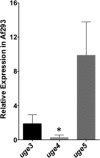
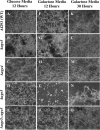
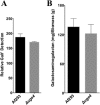
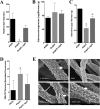
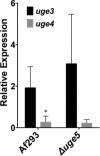

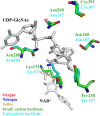
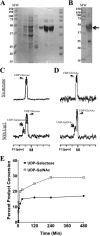
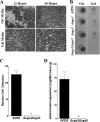


Similar articles
-
Functional redundancy and divergence of UDP-glucose 4-epimerases in galactose metabolism and cell wall biosynthesis in Aspergillus nidulans.Fungal Genet Biol. 2025 Mar;177:103972. doi: 10.1016/j.fgb.2025.103972. Epub 2025 Feb 21. Fungal Genet Biol. 2025. PMID: 39988081
-
UDP-glucose 4-epimerase isoforms UGE2 and UGE4 cooperate in providing UDP-galactose for cell wall biosynthesis and growth of Arabidopsis thaliana.Plant Cell. 2007 May;19(5):1565-79. doi: 10.1105/tpc.106.049619. Epub 2007 May 11. Plant Cell. 2007. PMID: 17496119 Free PMC article.
-
GfsA encodes a novel galactofuranosyltransferase involved in biosynthesis of galactofuranose antigen of O-glycan in Aspergillus nidulans and Aspergillus fumigatus.Mol Microbiol. 2013 Dec;90(5):1054-1073. doi: 10.1111/mmi.12416. Epub 2013 Oct 21. Mol Microbiol. 2013. PMID: 24118544 Free PMC article.
-
Galactosaminogalactan of Aspergillus fumigatus, a bioactive fungal polymer.Mycologia. 2016 May-Jun;108(3):572-80. doi: 10.3852/15-312. Epub 2016 Mar 1. Mycologia. 2016. PMID: 26932183 Review.
-
Specific molecular features in the organization and biosynthesis of the cell wall of Aspergillus fumigatus.Med Mycol. 2005 May;43 Suppl 1:S15-22. doi: 10.1080/13693780400029155. Med Mycol. 2005. PMID: 16110787 Review.
Cited by
-
Human Vγ9Vδ2 T cells exhibit antifungal activity against Aspergillus fumigatus and other filamentous fungi.Microbiol Spectr. 2024 Apr 2;12(4):e0361423. doi: 10.1128/spectrum.03614-23. Epub 2024 Mar 1. Microbiol Spectr. 2024. PMID: 38426765 Free PMC article.
-
Molecular characterisation of Entamoeba histolytica UDP-glucose 4-epimerase, an enzyme able to provide building blocks for cyst wall formation.PLoS Negl Trop Dis. 2023 Aug 24;17(8):e0011574. doi: 10.1371/journal.pntd.0011574. eCollection 2023 Aug. PLoS Negl Trop Dis. 2023. PMID: 37616327 Free PMC article.
-
Transcriptional Profiling of Myceliophthora thermophila on Galactose and Metabolic Engineering for Improved Galactose Utilization.Front Microbiol. 2021 Apr 28;12:664011. doi: 10.3389/fmicb.2021.664011. eCollection 2021. Front Microbiol. 2021. PMID: 33995328 Free PMC article.
-
Understanding Aspergillus fumigatus galactosaminogalactan biosynthesis: A few questions remain.Cell Surf. 2023 Jan 7;9:100095. doi: 10.1016/j.tcsw.2023.100095. eCollection 2023 Dec. Cell Surf. 2023. PMID: 36691652 Free PMC article. Review.
-
Immune Recognition of Fungal Polysaccharides.J Fungi (Basel). 2017 Aug 28;3(3):47. doi: 10.3390/jof3030047. J Fungi (Basel). 2017. PMID: 29371564 Free PMC article. Review.
References
-
- Ostrosky-Zeichner L., Casadevall A., Galgiani J. N., Odds F. C., Rex J. H. (2010) An insight into the antifungal pipeline: selected new molecules and beyond. Nat. Rev. Drug Discov. 9, 719–727 - PubMed
-
- Latgé J.-P. (2010) Tasting the fungal cell wall. Cell. Microbiol. 12, 863–872 - PubMed
-
- Latge J. P. (2009) Galactofuranose containing molecules in Aspergillus fumigatus. Med. Mycol. 47, S104–S109 - PubMed
Publication types
MeSH terms
Substances
Grants and funding
LinkOut - more resources
Full Text Sources
Other Literature Sources
Molecular Biology Databases

